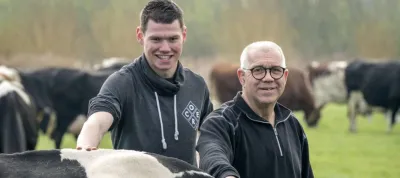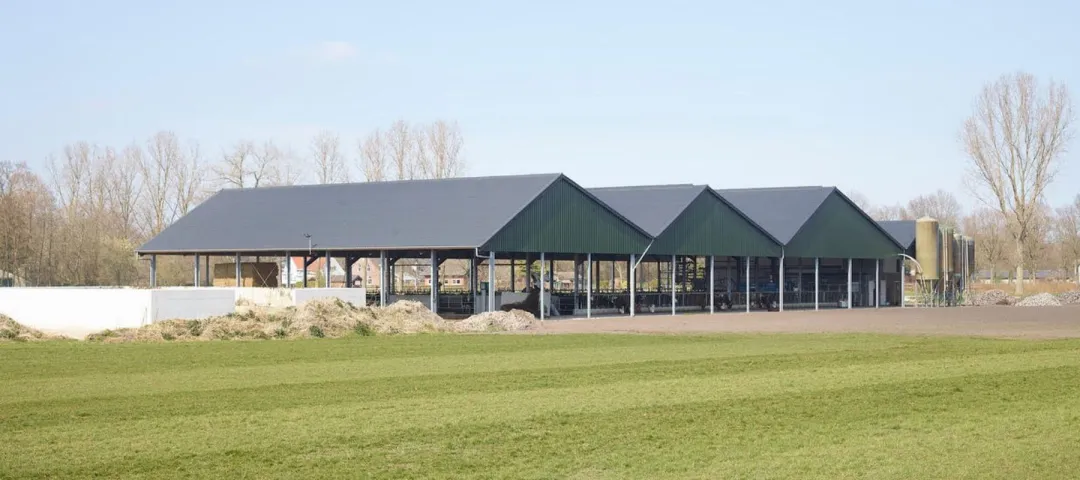General information
RDP Priority
- P2. Competitiveness
RDP Focus Area
- 2A: Farm’s performance, restructuring & modernisation
RDP Measure
- M04: Investments in physical assets
Beneficiary type
- Farmer / land manager
Summary
Dairy barn designs prioritising above-average space for cows enhance animal welfare by improving airflow and natural lighting, which are crucial for maintaining a healthy environment. Energy-efficient barn designs also contribute to reduced operational costs for farms while simultaneously enhancing cow comfort to help productivity.
A young Dutch dairy farmer called Bart Combee knew about these opportunities in barn design. He sought CAP funding to support plans for sustaining the resilience of his family farm in the southern municipality of Vught. This included converting farmland to a bird conservation area and constructing a ‘Kwatrijn’ livestock barn that also has facilities for cheese production (adding value to the dairy herd’s milk).
Bart’s new barn is animal and energy friendly with above-average space for cows. Roof design aligns with the landscape and its open sides offer access advantages. Livestock wastes are disposed of separately, reducing ammonia emission risks compared to traditional barn designs.
Results
Key results noted by the young farmer from his CAP funding are:
- reduced environmental impact and carbon footprint from the new barn as well as enhanced animal welfare and farm sustainability.
- increased farm revenue through value-added products supporting employment possibilities in dairy processing and farm management.
- 12 hectares of the farm have already been converted to natural land, used for extensive grazing and bird management.
- improved local biodiversity and landscape aesthetics.
- strengthened community engagement.

Promoter
Maatschap Combee
Funding
Total budget 791 907 (EUR)
RDP support: 125 000 (EUR)
Private/own: 541 907 (EUR)
Keywords
Ressources
Context
Dairy barn designs can be animal-friendly and energy-efficient, which is beneficial for both livestock and farm economics. Healthier cows are not only happier, but also tend to exhibit increased productivity levels. This translates to higher milk yields and lower veterinary costs because of improved animal health management practices.
Ample barn space minimises overcrowding stress, and increased natural light helps with better air quality by reducing odours and dust that can negatively impact livestock health. In this context, energy-efficient barn designs also contribute to reduced operational costs while simultaneously enhancing animal welfare.
A young Dutch dairy farmer called Bart Combee knew about these opportunities in barn design. He sought CAP funding to support plans for sustaining the resilience of his family farm in the southern municipality of Vught. This included constructing a so called ‘Kwatrijn’ livestock barn - which is an animal- and energy-friendly dairy farm building with above-average space for cows.
A ‘Kwatrijn’ is a four-line stanza, or quatrain, and the project concept can be seen to reflect this name by supporting the four pillars of business, welfare, climate, and community.
Objectives
This project aimed to use CAP co-funding for an investment that would:
- bolster the farming community’s economic resilience amidst fluctuating market conditions.
- demonstrate a viable model of sustainable dairy production.
- improve animal welfare through innovative barn design.
- reduce the farm’s ecological footprint through improved waste management, renewable energy adoption and integrated land management practices.
Activities
Part of the funding from the Common Agricultural Policy (CAP) was used for the development of the Kwatrijnstal, focusing on reducing emissions and enhancing environmental sustainability.
Additional CAP funds supported the conversion of farmland to natuurgrond (natural land), and the implementation of bird management practices.
The innovative, energy-neutral dairy barn replaced an older system, and was designed to reduce ammonia emissions by 50%, as well as enhancing manure quality.
The barn was designed with a specific roof shape aligned to the Dutch dairy landscape, and its open sides offer easier views of the activities inside
Barn features include on-farm milk processing options (processing milk into cheese for local consumers), straw islands and a special floor that separates solid manure and urine at the source, reducing ammonia emission risks compared to traditional barn designs.
Main results
Key results noted by the young farmer from his CAP funding are:
- increased farm revenue through value-added products supporting employment possibilities in dairy processing and farm management.
- reduced environmental impact and carbon footprint.
- enhanced animal welfare and farm sustainability.
- integrated renewable energy solutions.
- improved local biodiversity and landscape aesthetics.
- strengthened community engagement.
The barn’s location in the pastureland allows easier access for cows, reducing the need for mowing and promoting natural grazing.
12 hectares of the farm have already been converted to natural land, used for extensive grazing and bird management. The project includes plans to convert adjacent lands to nature grounds, aiming for self-sufficiency in feed and straw production.
Key lessons
Implementing animal-friendly and energy-efficient dairy barn designs is beneficial for both livestock and farm economics.
This Kwatrijnstal concept, integrating advanced barn design with sustainable energy solutions and on-farm processing, sets a benchmark for innovative agricultural practices in the region.
By ensuring adequate ventilation and cooling strategies, farmers can create a more conducive living space for their cows.
Barn designs that enhance animal comfort by optimising airflow and natural lighting help maintain a healthy environment.
As barn configurations like this become increasingly popular among dairy producers seeking sustainable farming solutions, they underscore the importance of integrating animal welfare with energy conservation in agricultural practices.
Bart Combee

